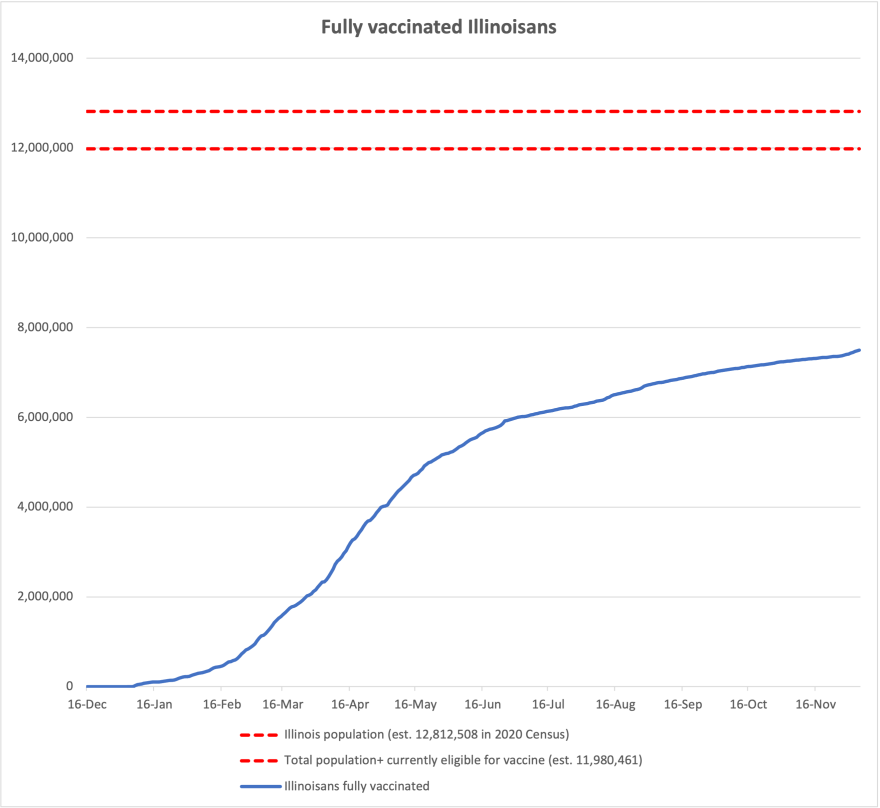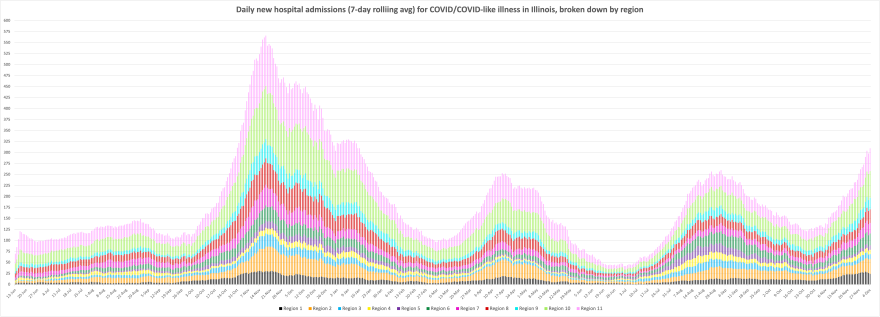A Chicagoan who’d been fully vaccinated against COVID and gotten a booster shot is the first confirmed case of the virus’ Omicron variant, state and city public health officials announced Tuesday evening.
But the person didn’t require hospitalization and is recovering after self-isolating at home. The news comes the same day as the nation’s top infectious disease expert said he’s seeing encouraging — but still preliminary — signs from the global epidemiology community that Omicron may cause less acute infections than previous versions of COVID.
“It appears that with the cases that are seen, we are not seeing a very severe profile of disease," Fauci said during a White House briefing.
"In fact, it might be — and I underscore might be — less severe as shown by the ratio of hospitalizations per number of new cases," Fauci told reporters during a White House briefing Tuesday.
But he said that low hospitalization ratio may be because it’s younger people who are getting infected, and they’re less likely to need to be admitted to the hospital.
Illinois Department of Public Health Director Ngozi Ezike on Tuesday stressed that it will take a while for scientists to know for sure just how Omicron works, including whether it is, indeed, even more transmissible than the Delta variant or the severity of disease it causes. In the meantime, she urged the usual list of COVID precautions, including masks, physical distancing, testing and getting vaccinated.
“As long as the virus continues to circulate, it has the potential to mutate into new variants,” Ezike said in a statement. “Vaccination can help stop circulation, but we need more people to get vaccinated.”
Next week will mark one year since the first healthcare workers in Illinois received their initial shots of Moderna’s COVID vaccine. Since then, 7.5 million Illinoisans ages 5 and over have gotten fully vaccinated — 59% of the state’s total population and 63% of those eligible — while another 769,000 people have gotten their first vaccine dose.

Hospitalizations up — again
Illinois has seen a 161% increase in the number of new COVID patients admitted to hospitals over the last six weeks, from 112 in a late October lull to 292 this week. As of Monday night, 3,029 COVID patients were hospitalized in Illinois — the most since late January.


COVID patients occupying ICU beds and on ventilators has not seen quite as high an uptick, though both are lagging indicators after a COVID infection lands someone in the hospital. ICU beds in the 20-county IDPH-designated southern Illinois region are in short supply with just six available as of Monday night.
Southern Illinois was hit hard by the pandemic’s late summer wave fueled by the virus’ Delta variant, facing an ICU bed shortage, patients were sent out of state — as far as Kansas City, St. Louis and Nashville — or placed in federal V.A. hospitals. At one point, the 22 hospitals in the region reported every single one of their ICU beds were occupied, meaning people who got into a car accident or had a heart attack wouldn’t have a place to go if they needed an ICU bed.


Earlier on Tuesday, Gov. JB Pritzker told reporters at an unrelated event that the state is once again providing staffing support for hospitals. He also relayed that after speaking with hospital leaders from across the state in the morning, the state is looking at ways to help hospitals deliver at-home monoclonal antibody treatments to COVID patients. Some hospitals are already providing those treatments in alternative spaces in their facilities so patients aren’t taking up hospital beds, Pritzker said.
But getting vaccinated to prevent the need for a hospital bed in the first place is the best thing Illinoisans can do to help ease the burden on the state’s healthcare system, he said.
“Those who are unvaccinated should get vaccinated right now,” Pritzker said. “The vast majority of the hospital beds are filled by people with COVID-19 are those who are unvaccinated. I’m very, very concerned that we make sure that our healthcare system and our hospital system are available for anybody who needs it at any time.”
According to IDPH data, only 0.05% of fully vaccinated Illinoisans have ended up hospitalized for a COVID infection, and even fewer — 0.014% — have died from the virus.
Highest COVID case numbers in months, but testing up too
The nine-county northwest Illinois region is seeing a disproportionate jump in hospitalizations, followed by seven weeks of increases in its COVID test positivity rate, topping out at a seven-day average of 10.4% last week. But in recent days, its positivity rate has seen a downtown — as have most of Illinois’ other 10 regions. However, it’s remains to be seen if the reprieve is just temporary.


Illinois’ overall COVID test positivity is 5.5%, though test positivity is not the reliable metric it was earlier in the pandemic. Increases in testing around big events — like Thanksgiving — and general higher numbers of COVID tests performed this fall due to testing programs in schools or workplaces makes the positivity rate harder to compare over time. Regular testing of the same groups of people will yield more negative tests, driving down the positivity rate.
But an increase in tests will also catch more asymptomatic cases, a likely factor behind IDPH reporting 11,524 cases last Thursday — the largest one-day total since early December of last year. That was out of 231,876 tests, which is the most results IDPH has ever reported in a single day, which blew the previous record out of the water by more than 50,000 tests.
An IDPH spokeswoman attributed the large number of cases and tests to it being a week out from a major holiday, and pointed to possible holiday-induced lag time.
“Thanksgiving was one week ago and we are starting to see cases associated with family gatherings and travel,” IDPH spokeswoman Melaney Arnold said in an email to NPR Illinois last week. “Additionally, there may be lags in reporting by laboratories over the long holiday weekend and we could see those results being reported now.”


Illinois’ COVID death toll has seen a recent uptick too, with IDPH reporting 78 deaths on Tuesday — the most in a single day since February. The vast majority of COVID deaths in 2021 have been unvaccinated people, pushing Illinois’ pandemic death toll to 26,698 as of Wednesday, with more than 3,000 probable COVID deaths.

Youths less likely to be vaccinated
Officials at Oak Park River Forest High School were met with protest over the weekend after suddenly announcing Friday evening that all extracurricular activities and athletics would be suspended due to an increase in COVID cases.
By Monday night, however, the school had reversed course and reinstated practices with required N-95 or surgical masks.
OPRF isn’t on IDPH’s list of school outbreaks last updated on Friday, but 163 public and private schools in Illinois are currently reporting outbreaks. Half of those are less than five cases, and most of the remainder are outbreaks smaller than 10. A handful are larger, but the start dates on the outbreaks are sometimes a month or two ago. The most recent beginning date for one of the larger outbreaks is Nov. 16, when Central School District in O’Fallon began experiencing a COVID spread that stood at 38 students and staff as of Friday.
While children and teens are least likely to get severe cases of COVID and need hospitalization, they’re also the groups most likely to get infected and spread the virus. Illinoisans 20 and younger have led the way in new COVID cases since early September, right after the school year began in most of the state.
Since kids ages 5 through 11 became eligible for Pfizer’s COVID vaccine a month ago, nearly 234,000 have gotten at least one dose — 21% of Illinois kids in that age group. Younger teens ages 12 through 15 have been eligible for COVID shots since mid-May after those 16 and over began getting vaccinated earlier in the spring. In the last seven months, 61% of all Illinois teens ages 12 through 17 have gotten vaccinated — a little more than 611,000.
The numbers are higher for adults: 74% of Illinoisans ages 18 through 64 have gotten at least one COVID shot, along with 92% of seniors ages 65 and up.
Interest in getting vaccinated dropped off in the summer and only picked up a little as Illinois was getting hit with the Delta variant in August and September. But about a month after federal and state health officials OK’d booster shots for adults 65 and over in September, the number of daily shots in arms began a sustained increase, buoyed by the approval of the Pfizer vaccine for kids 5 through 11 in early November and booster shots for all adults a few weeks later.

As of Wednesday, nearly 2.2 million Illinoisans had gotten their booster shots — 30% of the total number of Illinois who were already fully vaccinated. Booster shots are recommended for those 18 and over who got the second of their Moderna or Pfizer doses six months ago, and those who got a Johnson & Johnson shot at least two months ago.
A growing number of studies show immunity to COVID begins waning at the six-month mark — a milestone many fully vaccinated Illinoisans began hitting in October and November, just as colder weather pushed activities inside where the virus is spread more easily.
While Black and Latino Illinoisans had began to reach parity with white vaccination rates earlier this year, those communities are underrepresented in the number of booster shots given so far.
According to IDPH data, Latinos in Illinois have seen a disproportionate number of positive cases at many points during the pandemic, including a spike in early November. Black Illinoisans have died from COVID at a disproportionate rate, making up 18.3% of deaths from the virus, compared with the official 2020 Census data pegging Illinois’ Black population at 13.9%.
Copyright 2021 NPR Illinois | 91.9 UIS. To see more, visit NPR Illinois | 91.9 UIS. 9(MDIwMjIxMDA0MDE0Mzk4NDIzNjA0OGQ5Yg001))


